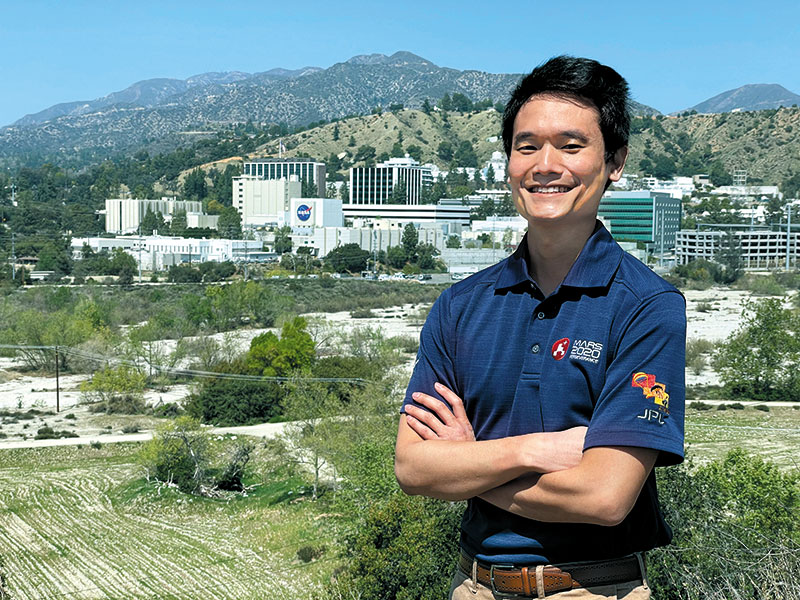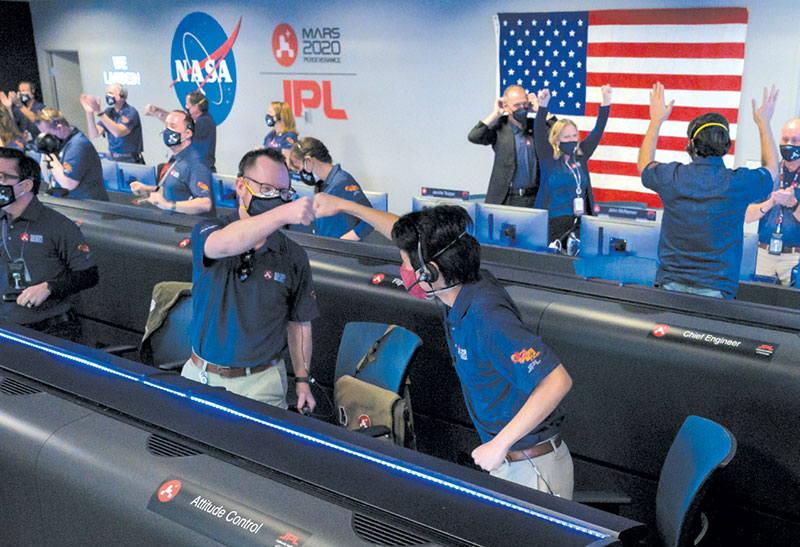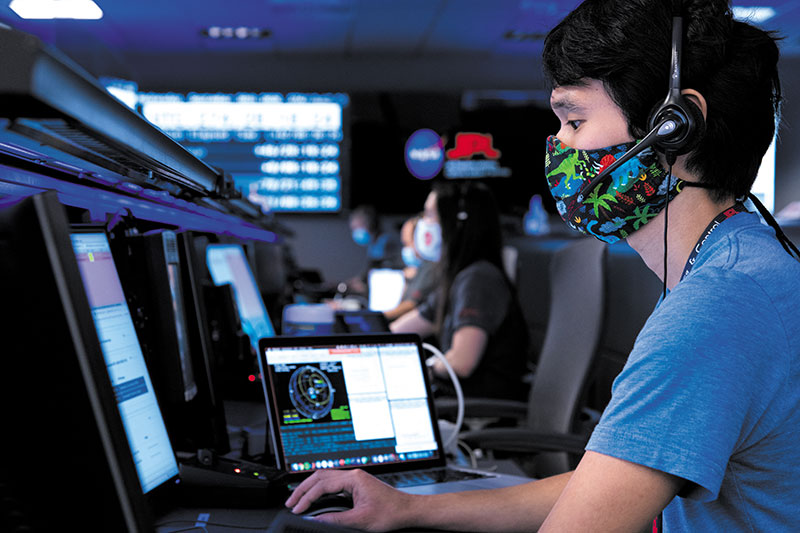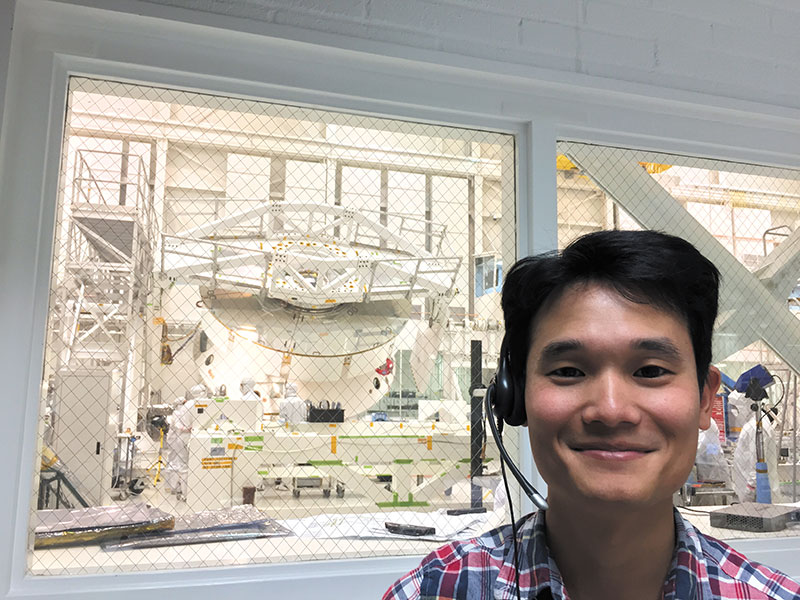The Right Stuff

As a guidance and control engineer for NASA’s recent “Percy” project, Christopher Pong is proving he has what it takes to explore the mysteries of the cosmos. Julia Pong photo
As a Guidance and Control Engineer for NASA’s recent “Percy” project, Christopher Pong is proving he has what it takes to explore the mysteries of the cosmos.
Ever since he was young, Christopher Pong has made it a point to keep his eyes fixed on the skies and beyond.
“Like many kids, I grew up wanting to be an astronaut,” recalls Pong, whose liftoff in life began in Kāne‘ohe, where he attended Kapunahala Elementary School. “I would read about Albert Einstein and Stephen Hawking. I also watched Bill Nye the Science Guy.
“Probably in third and fourth grades, I attended Future Flight Hawai‘i, which was a space camp on the Big Island,” he continues. “The first year I went with my dad for a few days and the second year I went alone for a week. We went out on the lava flows, sampled rocks and tested them for life. At the end, we gave a presentation to our families.”
Fast-forward to Feb. 18 of this year, and Pong’s job as a guidance and control engineer for NASA’s successful Perseverance rover landing on Mars has become the fulfillment of a lifelong dream.
“There were such a variety of emotions that I felt that day — exhaustion from not sleeping well the night before and adrenaline to balance it out; fear that something may go wrong and we could lose the entire mission. Those emotions just built and built as VIPs started entering the room and the livestream started,” remembers Pong, an alumnus of Punahou School.

Members of NASA’s Perseverance Mars rover team watch in mission control as the first images arrive moments after the spacecraft successfully touched down on Mars Feb. 18 at NASA’s Jet Propulsion Laboratory in Pasadena, California. Photo courtesy Bill Ingalls/NASA
“When I heard the words ‘touchdown confirmed,’ there was just a flood of joy and relief. The high-definition photos and videos of the landing that were down-linked in the following days were literally out of this world.”
Specifically, Pong served as an attitude control engineer on the project. In that role, he helped estimate the attitude, or orientation, of the spacecraft using a sun sensor and star scanner, and assisted in firing the thrusters to alter Perseverance’s flight pattern.
Pong explains that as the spacecraft cruises from Earth to Mars, it spins like a giant gyroscope. The spacecraft’s solar arrays and antennas are aligned with its spin axis, and therefore, attitude control engineers need to periodically turn the spacecraft to keep them pointed close enough to the Sun and Earth. The spacecraft is also purposefully launched on a trajectory that will miss Mars for planetary protection reasons.
Although he is currently working at NASA Jet Propulsion Laboratory in California, Pong’s interplanetary adventure has its beginnings in Hawai‘i.
Born to Randall Pong and May Akamine, Pong grew up under the protective wing of his big brother, Clinton, who today works as a Boston-based family doctor.
“He likes to brag about me on Facebook. I was shy as a kid so he would speak for me — and this pattern still continues to this day,” acknowledges the 34-year-old Pong.
In describing his childhood, Pong says, “My brother and I would explore the neighborhood, race down our cul-de-sac in our wooden go-kart, or swing down the zip line from our tree house. I played soccer and was a Cub Scout and Boy Scout. It was a very happy time in my life.”
Within the home, education was stressed by their parents. Whenever they would ask for a toy, their mom would respond with a simple question: “What’s the toy’s educational value?”
“Needless to say, that often stopped that conversation,” Pong declares. “But we did get pretty cool toys like K’NEX, Capsela or LEGO Mindstorms, which led to model rockets and building electronics like a radio and robot.”
Despite Pong possessing a sharp mind at an early age (his mother notes that her “very observant” son would soak up “knowledge and skills just by watching others”), he also has humility.
“When he was in middle school, I recall seeing his name in the Punahou bulletin. He had placed third in a national math competition. I asked him about it and he said it wasn’t a big deal and I responded, ‘Of course it’s a big deal! I’m so proud of you,’” Akamine explains.
Pong also possesses an artistic side. In high school, he created beautiful works of art, such as a nice painting of Humphrey Bog-art, pottery, glasswork and more, Akamine recalls.

Christopher Pong sports a dinosaur-themed mask during his participation in the Mars 2020 mission’s second trajectory correction maneuver at NASA’s Jet Propulsion Laboratory in Southern California. Photo courtesy NASA/JPL-CALTECH
However, she concludes that his love of rockets and science ultimately prevailed. He had, after all, expressed a desire to become a physicist even before turning 8.
“Besides being a physicist, he also wanted to be an astronaut and explore space,” she says.
And space is certainly on Pong’s mind a lot these days. He explains that his role on the Perseverance Mars project is largely over since he’s not directly involved with the operation of “Percy” — what the rover’s name has been shortened to — as it explores Mars.
“I am just analyzing telemetry that was recorded during cruise and just before entry, descent and landing so that we can learn from what happened and apply that knowledge to future missions,” he shares.
He adds that he is excited to see all the images that are downlinked every day showing the Martian landscape, close-up views of rocks and the various instruments on the rover being deployed.
In addition, Pong looks forward to the small robot helicopter Ingenuity’s first flight on Mars and Perseverance taking its first samples.
Pong is currently working as the guidance and control systems engineering lead on the proposed Sample Retrieval Lander, which will deposit both a Sample Fetch Rover and Mars Ascent Vehicle near Jezero Crater. The rover will pick up the samples that Perseverance will soon collect and bring them back to the rocket to be launched from Mars. Another mission — the proposed Earth Return Orbiter constructed by the European Space Agency — will grab the samples from orbit around Mars and send them back to Earth.
The engineer from O‘ahu has worked on the project for more than four years and says it has been a thoroughly amazing experience.
“It’s very cool to be working alongside senior engineers, some of whom appear in documentaries that I watched when I was just dreaming about working at a place like JPL. Everyone comes from such diverse backgrounds and shares a passion for space,” he sums up.
When he’s not working, Pong enjoys spending time with his wife, Julia, and their two children, 5-year-old Oakley and 3-year-old August.
“We love traveling internationally, but due to the pandemic, we’ve recently been camping in places around California. My wife and I met in college. She went to Scripps College, which is right next to Harvey Mudd College. After we graduated, we both moved to Boston for graduate school. She went to Boston University while I went to MIT,” Pong explains.

Pong at NASA’s Jet Propulsion Laboratory’s Spacecraft Assembly Facility. Photo courtesy Christopher Pong
“For a couple years, we lived together with my brother and his wife. We now live in South Pasadena, where my wife runs an in-home daycare with six kids, including our two,” he adds.
Pong shares that his experience as a student at Punahou School certainly set him up for success in his career.
“One thing that started at Punahou, for me, was learning through teaching,” he emphasizes. “In my AP Calculus BC class, I was given the opportunity to teach a lesson or two to my fellow classmates. In AP Physics C, we were always split up into small groups and we’d have to work through problems together as a team. This taught me that being able to explain a concept to someone else requires a much more deep under-standing of the material.
“This is something that I keep in mind to this day and I believe it’s why some of the most knowledgeable people that I work with are so willing to sit down and answer questions from junior engineers,” he concludes.
He also recalls one fun thing that just happened to him a few weeks ago when he participated in a Zoom chat question-and-answer session about Perseverance, organized by Art and Rene Kimura, who started Future Flight Hawai‘i. Three of the participants were his favorite teachers from Punahou (Christine David, Susan Field and Michael Gearen), who he hadn’t seen since he graduated almost 17 years ago.
“It was awesome to reconnect with them (briefly) after all of these years!” Pong declares excitedly.
Although many questions remain to be answered about the nature of the enigmatic planet Mars, one thing is certain. Pong has definitely had a “blast” in taking part in its exploration.





